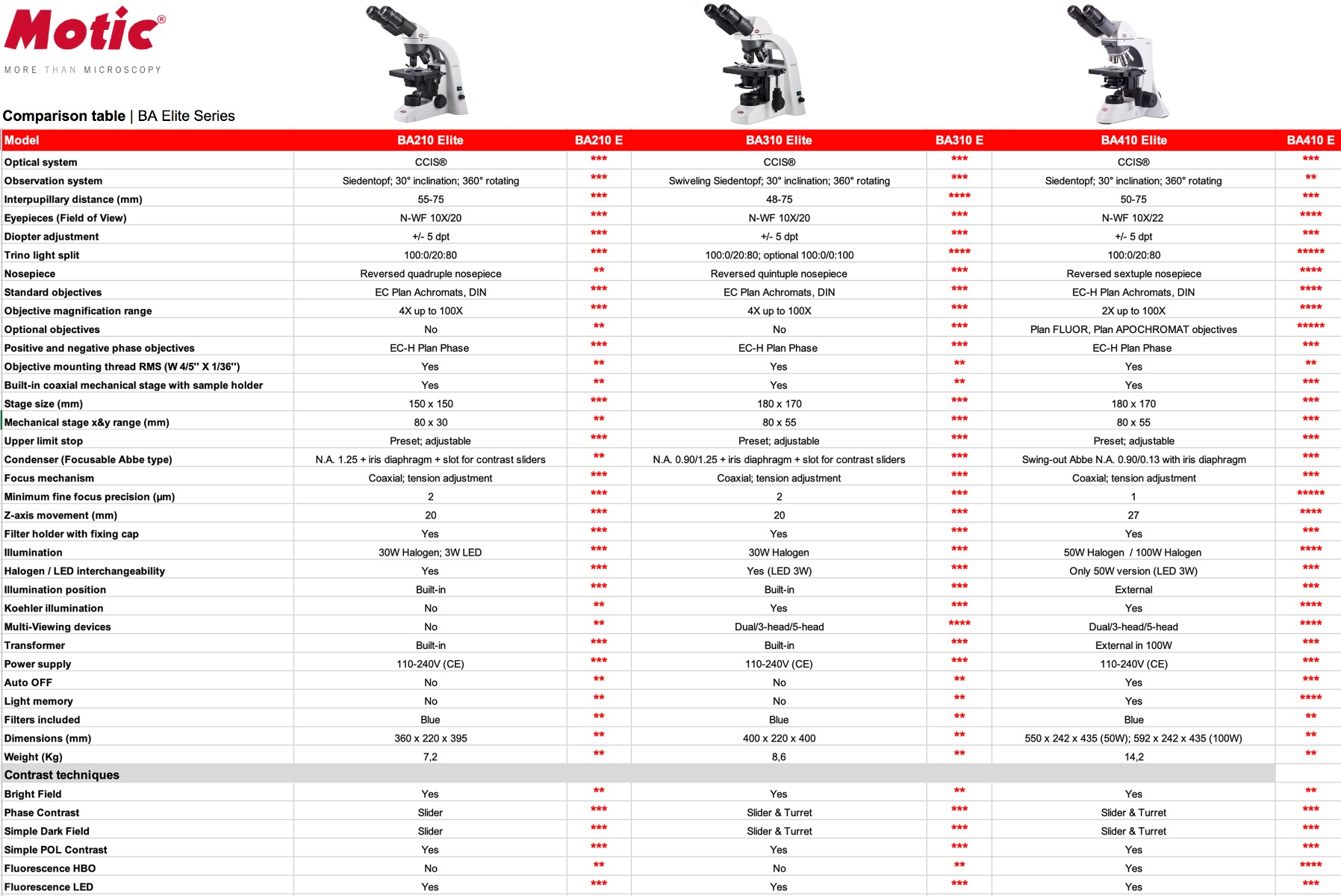Category: Advanced Transmitted Light Microscopes
Target specimen: Transparent samples (sections, smears, emulsions, water samples) from Biology & Medicine; rarely from Industry
Target customer: Lab technicians
This comparison is an approach for classifying different microscope models in a defined performance range. Here we are talking about Motic’s BA Elite series of Advanced Transmitted light microscopes, meant for routine work in university and biomedical lab. The comparison is meant to help you in finding a suitable solution for your lab.
The following chart is based on the specifications of the basic outfit for each model and its upgradeability options. Our rating of the single specifications rests upon an individual understanding of the actual numerical values. This is a subjective rating, and we understand that each person might have its own opinion.

All technical features are judged on the impact in practical microscopical work. Two examples: A system with Field of View 22 (BA410E) presents 21% more visible area than a FOV 20 (BA210E, BA310E). A quicker overview, less work to move the X/Y stage, faster results: we rated this feature with a score of “****”. The stage size, although different in BA210E vs. BA310E/BA410E, has been rated with an equal score (***). Does the stage size really affect the efficiency of daily microscopical work? The travel range seems to be more important and thus has been classified with individual scores.
Upgradeability is also ranked following the practical impact in laboratory work. A turret condenser gives more flexibility, but by performance is not superior to a slider solution.
The final chart displays an evident fact: The models BA210E and BA310E are close to each other in performance, significantly separated only by the Koehler illumination. BA410E is far beyond, especially regarding upgradeability, although some features (no swiveling eyepiece tube, no Halogen/LED interchangeability in 100W version) deserve a low rating.
Some remarks:
Interpupillary distance: Young people and female users by nature have a small eye distance. For a long-term work, the tube should be adjusted properly. BA310E offers the broadest range in interpupillary distance. A microscope user should know his own value before purchasing a microscope.
Field of View: The larger, the better. The calculation is as follows: Visible Area (mm2) = ¶ x r2. An advantage of 21% can be granted to BA410E in comparison to BA210E/BA310E. 21% more visible area at one view without moving the X/Y-stage: a time saving feature, especially interesting in case of a high sample throughput or a fast review of large samples.
Trinocular beam split: A 100:0/0:100 split with a 100% light option to the camera port is recommended in case of light consuming contrast methods, especially for Fluorescence. The BA410E with its triple beam split option offers maximum flexibility for all observation/documentation cases.
Objectives: The necessary quality of objectives is deeply depending on the application. No description can beat a test with own samples. As objectives are a major price point, the user may think about a mixture of objectives, choosing a first-class objective (in most cases probably a 40X) as a workhorse and a set of basic objectives as its completion.
Objective range: The EC-H 2X objective in BA410E offers a visible area of 11mm diameter, the size of a thumbnail. Perfectly matching requests from pathology, but also able to close the gap between compound and stereo microscope magnification range in terms of visible field.
Fine focus: The minimum increment of the fine focus is essential for the evaluation of the sample in Z direction. The smaller the value, the better. With a small increment, it is much easier to get a 3D impression even from sections when focusing.
Illumination: The more power, the better the chances for the old fashioned Multi-Viewing Devices. Almost extinct, but still the best setup for an individual teaching. This hardware is the only way to transfer the complete Field of View to a second/third person. Any camera solution will lose plenty of visible field.
Halogen/LED interchangeability: LED illumination is the modern approach in terms of life-time and color temperature. For image documentation, modern digital cameras have got several tools to compensate the disadvantage of Halogen illumination in terms of color temperature: White balance.
Koehler illumination: A difficult case. Even on university level, some teachers do not know the importance of a proper Koehler setup for the evaluation of tiny, thin and hardly stained structures. This hardware addition (e.g. Field diaphragm) is going to become neglected. A clear recommendation from our side: If possible, the customer should go for a microscope with a Full Koehler illumination.
Fluorescence: HBO Fluorescence is still more flexible than most LED solutions. New dyes, multiple staining: this is best done with a Mercury light source. For standardized Fluorescence applications with a single staining, LED Fluorescence may be adequate. Especially in educational environments, LED is strongly privileged. No need to care for the Mercury disposal of old bulbs or the risk of breaking a bulb.
Summary: The selection of a specific model always depends on impartial demands and individual preferences. Depending on each individual needs and the application range, there is more than one correct decision to solve a specific application case.
